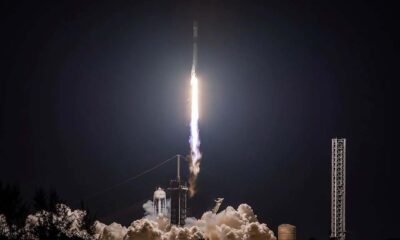SpaceX
SpaceX Falcon 9 launches USSF-62 mission with Weather Systems (WSF-M) satellite

SpaceX on Thursday launched a new Falcon 9 launch vehicle with the U.S. Space Force (USSF)-62 Weather Systems Follow-on-Microwave (WSF-M) satellite under the Space System Command (SSC) Space Sensing Program.
This was the first National Security Space Launch mission to lift off from Vandenberg Space Force Base in nearly two years.
The mission was conducted from Space Launch Complex 4 East at Vandenberg Space Force Base in California. The company gave a weather update on social media site X (formerly Twitter), calling it 95 percent favorable for the liftoff.
Liftoff of USSF-62 – SpaceX’s 12th National Security Space Launch on a Falcon rocket pic.twitter.com/PPryxZnOCE
— SpaceX (@SpaceX) April 11, 2024
The satellite was made possible with the collaboration of Space and Space Sensing program executives who worked together for the last several months.
WSF-M, in particular, is a next-generation, operational, low-earth orbit, monitoring satellite system from DoD. It is designed and developed to provide continued space-based terrestrial environmental sensing capabilities.
The satellite will collect weather and unmoved space environment observations from sun-synchronous LEO. It will augment key capabilities, which is currently provided by the legacy Defence Meteorological Satellite Program (DMSP).

U.S. Space Force (USSF)-62 Weather Systems Follow-on-Microwave (WSF-M) satellite loaded in Falcon 9 payload fairings (Image Credit: SpaceX)
WSF-M satellite is part of SSC space-based environmental monitoring (SBEM) architecture and its data will be used by armed forces and U.S. allies daily.
This satellite is the first of two WSF-M satellites launched into orbit. This new launch starts USSF’s next-generation satellite deployment and modernization of space-based environmental monitoring systems.
SSC procured this launch during the third order year of the National Security Space Launch (NSSL) phase 2 contract awarded in August 2020.
The first-stage rocket used in this mission is completing its third launch and previously supported two Starlink missions. After separation, the first stage landed on Landing Zone 4 (LZ-4) at Vandenberg Space Force Base.
Falcon 9’s first stage has landed on Landing Zone 4! pic.twitter.com/OODHRzpFe7
— SpaceX (@SpaceX) April 11, 2024
(source)












